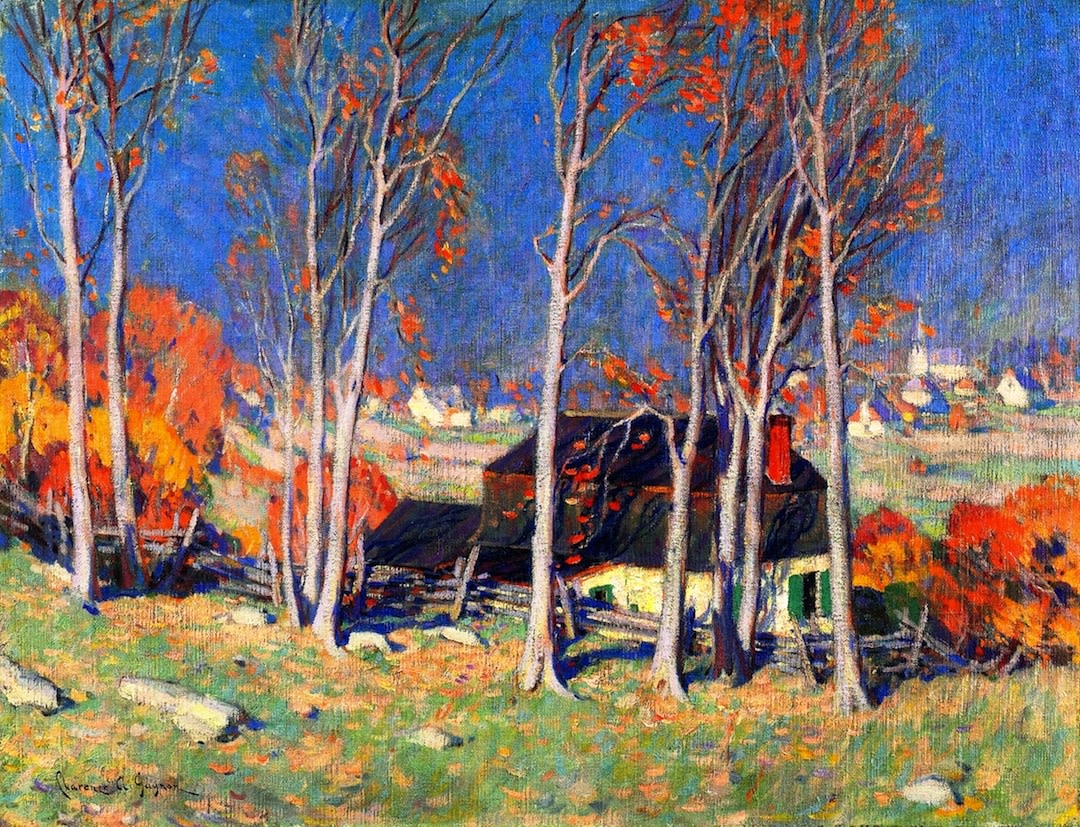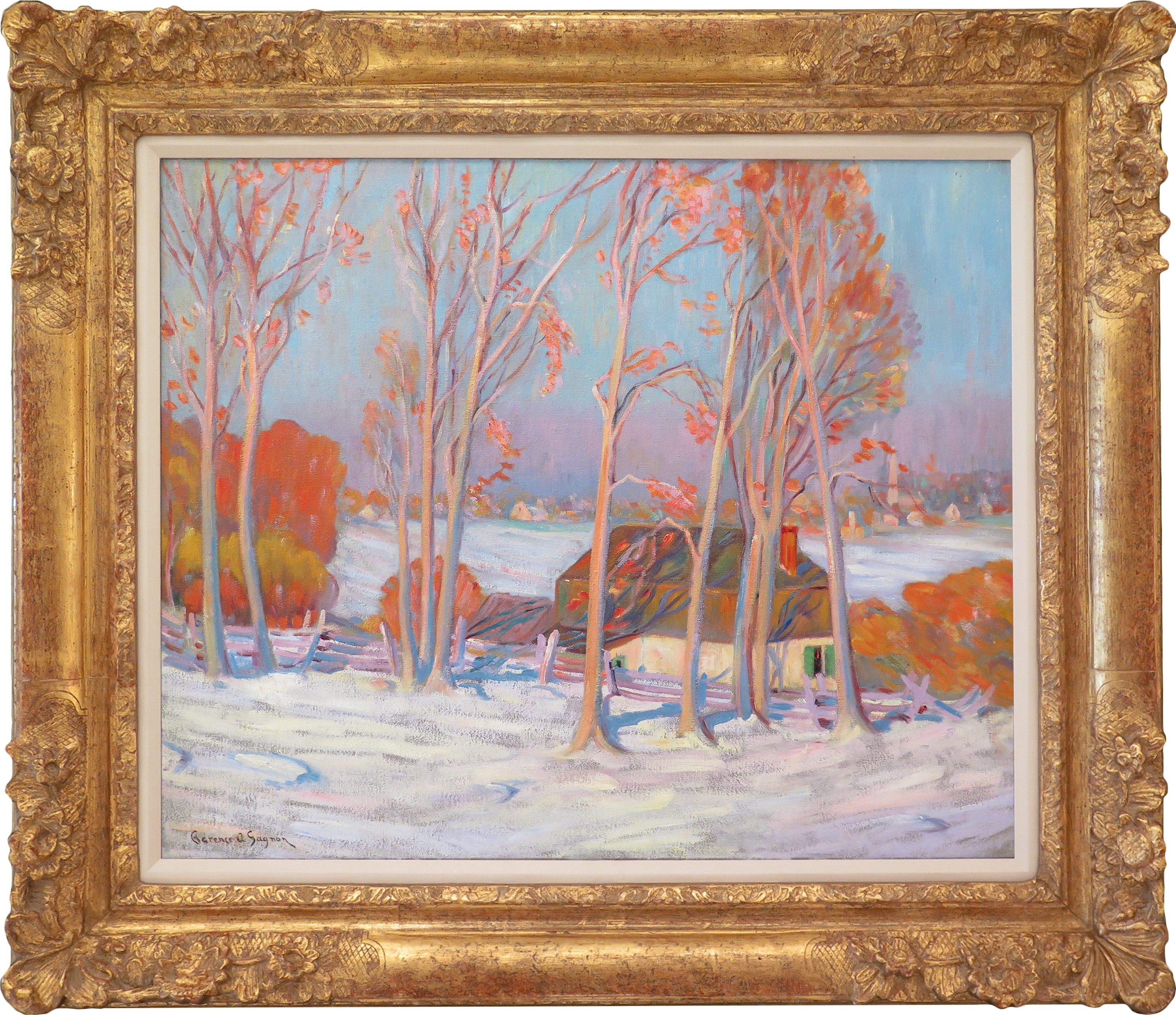Rare and Striking Clarence Gagnon Canvas at Alan Klinkhoff Gallery
"...The incomparably bright effect of glowing light reflecting off of the snow-laden ground and emanating from the vivid masses of leaves."

In June 1919, Clarence Gagnon was back in Canada after having made an enviable name for himself in France as a painter and engraver. Approaching his 40s, the artist was in no hurry to return to the City of Lights, where he had spent the past 15 years. He decided to take in the seasons in his beloved Charlevoix region, nestled in the Laurentians, far from the hustle and bustle of Paris. This fourth sojourn, which stretched to December 1924, was his longest and last before his definitive return to Canada in 1936.
A wind of renewal is evidenced in these five years of happiness and intense work. Gagnon put down permanent roots in Baie-Saint-Paul with his young wife, Lucile Rodier. He developed joint projects with village craftspeople, in the wake of the Arts and Crafts movement. He created his own colours from ground pigments; this research was rewarded in 1923 by New York’s Salmagundi Club, which presented Gagnon with the Trevor Prize for the vivacity and chromatic purity of his small work Winter in the Laurentians, Quebec, 1922 (private collection). His approach to landscape painting evolved with a more decorative sensibility, favouring plays of arabesques on smooth surfaces and opposing warm and cool colours. Close to 30 exhibitions showcased his new rustic scenes before he returned to Paris at the end of 1924. Elected to the Royal Canadian Academy of Arts in 1921, he was invited to take part in the preparations for and to exhibit in the 1924 and 1925 Canadian section of the British Empire Exhibition at Wembley Park in London, which was sponsored by the National Gallery of Canada.
First Snow Baie St. Paul was undoubtedly painted during this fourth stay in Canada. As Gagnon was not in the habit of systematically dating and titling his works, it is no surprise that this winter landscape, signed by the artist, lacks any indication as to its exact date [1]. In addition, the painting was scarcely shown in public during the artist’s life or after his death. For many years it was part of a private collection [2]. In September 1975, it was exhibited under its current title at the Walter Klinkhoff Gallery in Montreal [3], along with 69 other paintings and pochades (oil sketches) by Clarence Gagnon, all but three of them from private collections [4]. Full of revelations, the exhibition included another painting with a similar title, First Snow in the Mountains. The presence of these two paintings on the theme of first snowfall is in itself remarkable. If we are to rely on the inventory of works by Gagnon shown since the start of the last century, there is no mention of “first snow” in the title of any painting [5]. Around 1930, Gagnon created a beautiful depiction of first snow in one of his illustrations for Louis Hémon’s novel, Maria Chapdelaine. The vignette at the beginning of Chapter 8 combines a dusting of October snow with the many-tinted red and gold leaves of aspens, alders, and white and yellow birches [6].
During his numerous skiing excursions in Charlevoix, equipped with his painter’s gear, Gagnon created pochades of this theme. Those that did not serve as studies for paintings were sold by Gagnon’s dealers to collectors, who snapped them up. Gagnon apparently skipped the oil sketch step when he did the painting in the Bloom collection. He created this first snowfall scene by carefully reproducing the composition of another painting. Now part of the collection of the Art Gallery of Ontario (AGO), the latter, a brilliantly hued fall landscape entitled Lonely Village on the St. Lawrence (illustration), painted in 1922, was initially called Indian Summer. It celebrates the warm, sunny days that follow the first fall frosts, just before winter. After having been exhibited a few times, the work entered the Art Gallery of Toronto (now the Art Gallery of Ontario) in 1926 under its current title [7]. The Art Gallery of Ontario subsequently included it in retrospectives and monographs dedicated to the artist.
In First Snow, Baie St. Paul Gagnon substituted the striking effect of pure, sharp contrasts of light found in his Indian Summer with the incomparably bright effect of glowing light reflecting off of the snow-laden ground and emanating from the vivid masses of leaves. To depict this remarkable day, when the approaching winter can already be felt but the leaves have not yet lost their bright autumn shades, the painter opted for a palette of pastel tones and a freer transcription of certain motifs. Had the two canvases been reunited, the identical-format paintings would have formed a pair, which celebrates the October splendor, with its unique weather. But did Gagnon ever intend to show the two works together? The famous case of the fall and winter versions of The Wayside Cross being shown in 1916 and 1917 at the annual RCA and AAM exhibitions, respectively, in Montreal, suggests that the artist elected not to display the two paintings together [8]. Regardless of Gagnon’s intentions, First Snow, Baie St. Paul and Indian Summer do not appear to have crossed paths, at least not to date.
Illustration

Clarence Gagnon, Lonely Village on the Saint Lawrence, 1922, oil on canvas, 51.1 x 66.4 cm, Art Gallery of Ontario, Toronto, gift from the Reuben and Kate Leonard Canadian Fund, 1926 (838).
Notes
1. Despite the indication “ca. 1910” on the Walter Klinkhoff Gallery label on the back of the frame.
2. On the back of the frame, a damaged Watson Art Galleries of Montreal label shows the provenance of First Snow, Baie St. Paul as the collection of “Madame Gagnon.” The painting was then owned by collector and philanthropist Adele Bloom of Westmount, who was active in the Montreal arts scene for many years, notably as a volunteer docent at the Montreal Museum of Fine Arts.
3. On the back, a Walter Klinkhoff Gallery label shows that the work bore the number 4 during the exhibition.
4. The three works were loaned by the Musée du Québec (now the Musée national des beaux-arts du Québec).
5. Other than First Snow in Norway, a pochade done between 1929 and 1936, included in the Arts Club of Montreal Memorial Exhibition in February 1943. See the selective list of exhibitions in Clarence Gagnon: Dreaming the Landscape (exhibition catalogue), by Hélène Sicotte and Michèle Grandbois (Quebec City/Montreal, Musée national des beaux-arts du Québec, Les Éditions de l’Homme, 2006, pp. 392-409).
6. The vignette — see the monotype kept at the McMichael Canadian Art Collection (1969.4.28) — mirrors the opening lines of Chapter 8: “One October morning Maria’s first vision on arising was of countless snow-flakes sifting lazily from the skies.” It depicts a river landscape that shares only the presence of glowing red hardwoods in a snowy setting with First Snow, Baie St. Paul
7. See number 89 in the exhibition catalogue Clarence Gagnon: Dreaming the Landscape, p. 352. The pochade Laurentian Homestead, Baie St. Paul, done in 1920, served as a model for the painting at the AGO.
8. The Wayside Cross, Autumn, 1916, oil on canvas, 56 x 74.5 cm. Collection of the National Gallery of Canada, purchased in 1916 (1367); The Wayside Cross, Winter, 1916 or 1917, oil on canvas, 71.1 x 94 cm., Thompson Collection (PC0144)





